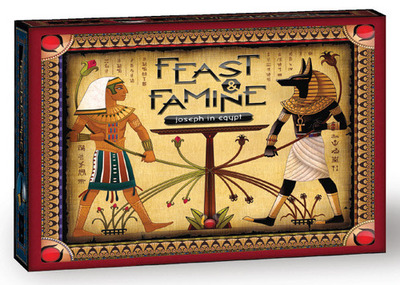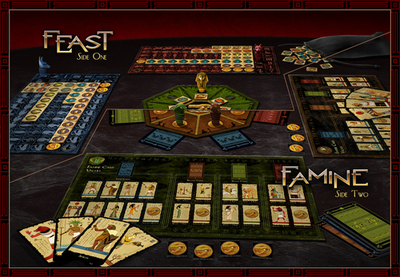 Feast & Famine - Does it Serve Up a 4-Course Meal or Will it Leave You Starving?
Feast & Famine - Does it Serve Up a 4-Course Meal or Will it Leave You Starving?

Feast & Famine: Joseph in Egypt is the first unplugged game produced by Good Knight Games in early November of '10. It was designed by Jason Conforto and illustrated by Ryan Braman and after opening the box, you can tell immediately that these two gentlemen cared about producing a quality game. This game is meant for 2-4 players and, depending on if you play feast, famine, or both, game time could range from 10-60 minutes.
To begin with, this game takes its influence from a theme that is rarely touched upon and hardly ever successful in the mainstream gaming industry, digital or analog. That is, the game takes its influence from a biblical story. In this case, the story comes from Genesis and its main character is Joseph. He has an interpretation of Pharaoh's dream that Egypt will be inflicted with 7 years of bountiful harvest, followed by 7 years of utter famine and devastation. While the theme is based off a biblical premise, the game doesn't throw it in your face. The only thing biblical about the game is the theme and two verses used as context for the different phases in the instruction manual. The board, the figure markers, the tokens, and the cards all lean towards the Egyptian style more than anything.
The Game Pieces
The physical pieces of the game are very well-crafted. It comes with a large black sack for the food and pharaoh tokens, five solid and well designed markers, the game board, the player boards, and the character cards. The tokens are made of heavy stock with clear illustrations. The two types of tokens come mixed together in the bag and one of the first things we did was separate the two. We also took one of the plastic bags and used it to store the pharaoh tokens for future play. It would have been more convenient if the tokens were separated to begin with; however, it wasn't a big issue. The markers are made of a nice thick resin and sport the images of the Pharaoh, Anubis, Amun-Ra, a sphinx, and a scarab. Both the game and player boards are dual sided, one side for Feast and the other for Famine. The player boards for Feast can be a little busy and slightly confusing at first. A suggestion would be to make the pharaoh token slots a different background color to help differentiate them from the food tokens. One thing that stuck out about the game pieces were the illustrations. Throughout the game the illustrations were simple, elegant and clear from the box cover to the tokens.
Game Play
The game is extremely easy to learn. The instruction manual has a whopping four pages to it, with almost the entire fourth page dedicated to listing the character card values. The objective of Feast is to earn as many pharaoh tokens as possible during the seven turns (years). Each player takes their turn purchasing food cards with their labor points to fill up their boards vertically or horizontally. When all of the spaces of a row or column are filled, the player earns a pharaoh token. The player with the most pharaoh tokens at the end of the seventh turn wins. There is some strategy involved but the premise is simple enough for a young child to understand, making this phase very family friendly. If the players wish to continue on to the Famine phase, then the earned pharaoh tokens are used.
Famine game play is just as straight forward as Feast. If the players haven't played Feast first, everyone starts with the same number of pharaoh tokens; otherwise success in Famine will be determined, in part, by how well the player did during the Feast. The players use their pharaoh tokens to bid on the face down character cards, with highest bidder winning the auction. After all (surprise!) seven turns have been completed, players add up the point values of their character cards. The player with the highest total wins.

Our Thoughts
Feast & Famine is a beautiful and simple game that is easy to learn and fun to play. It only takes a few minutes to understand each phase. The board and game pieces are high quality, although the scarab sort of looks like a turtle (we like turtles so it's okay).
Between the two different game types, Feast definitely takes the cake for fun value, although it relies more on luck, as it really depends on the draw of the food cards. The first game we played we almost filled up our game boards, but subsequent plays weren't nearly as lucky. We originally thought we did something wrong the first round, like forgetting to move the Pharaoh pawn after a turn, but it seems to be more of how the tokens are drawn from the bag. The more of the same type of food laid on the game board, the more likely you are to earn pharaoh tokens.
Adding more players doesn't seem to have much of an affect on strategy for Feast as it does for Famine. The biggest determining factor is how many people you have to bid against. A bidding war between two people isn't quite as exciting as a war between all four players.
Overall, this was an excellent game both conceptually and visually. However, the simple game play mechanics are its biggest downfall. It lacks depth and, after a few games, begins to lack a challenge, making replay value to be desired. Although Feast & Famine: Joseph in Egypt has some minor flaws, it is a great first release from Good Knight Games. We give it a 3.5 out of 5 stars.
Read More in: Board Games | Our Game Reviews
Share this Article with others: 
Related Articles:
Came straight to this page? Visit Critical Gamers for all the latest news.
Posted by Critical Gamers Staff at February 24, 2011 8:30 PM
